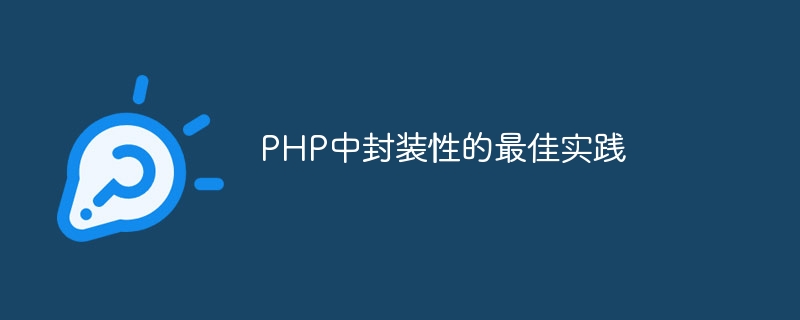Home >Backend Development >PHP Tutorial >Best Practices for Encapsulation in PHP
Best Practices for Encapsulation in PHP
- WBOYOriginal
- 2023-10-12 08:35:24907browse

The best practice of encapsulation in PHP
Encapsulation is a very important concept in object-oriented programming. It can help us hide the code logic inside the class. , and provide a secure access interface to the outside world. In PHP, encapsulation best practices are key to code maintainability and scalability.
- Using access modifiers
In PHP, we can use three different access modifiers to control the visibility of properties and methods, which are public, private and protected. - Public means that the property or method is visible to all objects, and they can be accessed both inside and outside the class.
- Private means that the property or method can only be accessed inside the class, and they are completely hidden from the outside world.
- protected means that the attribute or method is visible to the interior of the class and inherited subclasses, but is hidden from the outside world.
By using access modifiers appropriately, we can hide properties and methods that are only used within the class to avoid unnecessary interference and dependencies from the outside world.
- Use getter and setter methods
In the concept of encapsulation, we should also avoid directly accessing and modifying the properties of the class. Instead, we should provide getter and setter methods to access and modify the value of the property. This approach provides better flexibility and maintainability.
For example, we have a class Person, which has an attribute $name representing the person's name. We can define a getter method getName to get the value of $name, and a setter method setName to set the value of $name. In this way, when used externally, we get the name by calling the getName method and set the name by calling the setName method. In this process, we can control the legality of the input and attach other logic.
Sample code:
class Person {
private $name;
public function getName() {
return $this->name;
}
public function setName($name) {
if (strlen($name) >= 2 && strlen($name) <= 10) {
$this->name = $name;
} else {
throw new Exception('姓名长度必须在2到10个字符之间');
}
}
}
$person = new Person();
$person->setName('张三');
echo $person->getName(); // 输出:张三
$person->setName('李'); // 抛出异常,姓名长度必须在2到10个字符之间By using the getter and setter methods, we can verify and process the input data to ensure the integrity and security of the data.
- Using namespaces
In large projects, we often encounter conflicts in class names or function names. To solve this problem, PHP provides the concept of namespace. Use namespaces to organize classes or functions with similar functions together and ensure that there will be no conflict when using the same class or function name in different namespaces.
Sample code:
// 文件: User.php
namespace MyAppModels;
class User {
private $name;
public function getName() {
return $this->name;
}
public function setName($name) {
$this->name = $name;
}
}
// 文件: Order.php
namespace MyAppModels;
class Order {
private $user;
public function setUser(User $user) {
$this->user = $user;
}
public function getUser() {
return $this->user;
}
}
namespace MyApp;
// 使用User类
$user = new ModelsUser();
$user->setName('张三');
// 使用Order类
$order = new ModelsOrder();
$order->setUser($user);By using namespaces, we can group related classes and reduce the possibility of naming conflicts.
Summary:
In PHP, encapsulation is an important concept in object-oriented programming. By using access modifiers to control the visibility of properties and methods, using getter and setter methods to access and modify property values, and using namespaces to organize classes and functions, we can improve the maintainability and extensibility of our code. The above are the best practices for encapsulation in PHP, with specific code examples.
The above is the detailed content of Best Practices for Encapsulation in PHP. For more information, please follow other related articles on the PHP Chinese website!
Related articles
See more- phpstudy usage instructions tutorial
- PHP collection plug-in QueryList practical teaching (1)
- Best practices for authentication using JWT in Go
- Tips and best practices for implementing revolving lanterns and carousels in Vue
- Best practices for using gRPC to implement concurrent data transmission in Golang

